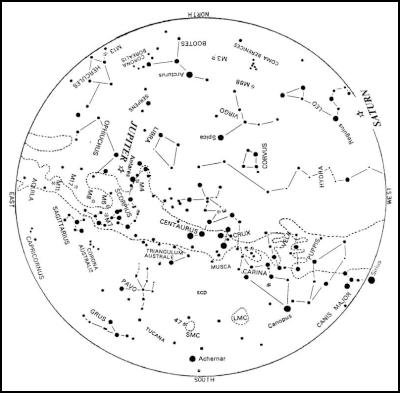The June Night Sky
Carter Observatory
The National Observatory of New
Zealand
THE NIGHT SKY
Brian Carter*
THE JUNE NIGHT SKY
June is the month with the longest nights and shortest days.
Planets
June is an excellent month for viewing the planets. Venus, Mars, Jupiter and Saturn will be visible for all of the month. Mercury will be visible for all but the very end of the month.
Mercury will be visible in the Western evening sky for all but the end of June. At the start of the month it sets at 18 26, by June 7 at 18 29 and at 17 08 by month’s end. Mercury is in the constellation of Gemini. During June it very rapidly fades from 0.4 to 5.0.
Venus will be visible in the Western evening sky. At the start of the month it sets at 20 09 and at 20 34 by month’s end. Venus starts the month in the constellation of Gemini, moving into Cancer on June 4 and finally into Leo on June 27. Its brilliant magnitude slightly increases from –4.3 to –4.4 during June.
Saturn will be visible for the first quarter of the night. At the start of the month it sets at 22 17 and at 20 37 by month’s end. Saturn is in the constellation of Leo, in which it remains until September 2009. Its magnitude slightly fades from 0.5 to 0.6 during the month.
Jupiter will be visible for all of the night, except at the end of the night towards the end of June. At the start of the month it sets after Sunrise and at 05 59 by month’s end. Jupiter is in the constellation of Ophiuchus, in which it remains until 2007 December. Its magnitude slightly fades from –2.6, it’s brightest for the year, to –2.5 by month’s end.
Mars will be visible for the last quarter of the night. At the start of June it rises at 02 42 and at 02 36 by month’s end. Mars start the month in the constellation of Pisces, moving into Aries on June 28. Its magnitude slightly brightens from 0.8 to 0.7 during the month.
All times are for Wellington unless otherwise stated. Other centres may vary by a few minutes.
Phases of the Moon
Full Moon – June 1 at 13
04.
Last Quarter – June 8 at 23 43.
New Moon –
June 15 at 15 13.
First Quarter – June 23 at 01
15.
Winter Solstice
The Southern hemisphere Winter Solstice is at 06 06 on June 22. This is when the Sun is at its most Northerly point in the sky and therefore at its lowest altitude at the middle of the day in the Southern hemisphere. Mathematically this means that the longest night is June 21/22 and the shortest day is June 22. We say “mathematically”, as the nights and days are longer or shorter than the adjacent nights and days by only a few seconds, whereas actual Sunrise and Sunset times can vary by up to 3 or 4 minutes due to atmospheric conditions. This large variation means that any of the nights or days around the Solstice could actually be the longest or shortest.
Diary of Astronomical Phenomena
June
1 Full Moon at 13 04.
2 Jupiter 6°N of Moon at 00 00.
2 Mercury at greatest Easterly elongation from the Sun
(23) at 22 00.
6 Jupiter at opposition (on the
opposite side of the Earth to the Sun) at 11 00.
9 Venus
at greatest Easterly elongation from the Sun (45) at 15
00.
13 Moon at perigee (closest to the Earth) at 05 00.
(Distance = 0.0024317 AU = 363,780 km).
15 New Moon at 15
13.
16 Mercury stationary against the background stars at
04 00, as its motion changes from an Easterly to a Westerly
direction.
19 Saturn 0.4° S of Moon at 20
00.
22 Winter solstice at 06 06.
25 Moon at apogee
(furthest from the Earth) at 02:00 (Distance = 0.0027042 AU
= 404,540 km).
28 Occultation of Antares but the Moon at
~18 00. (See above).
28 Jupiter 6°N of Moon at 02
00.
29 Mercury in inferior conjunction (between the Earth
and Sun) at 07 00.
MAY SKY CHART
This chart shows the sky as it appears at about 21:00 for ~June 15.

Click to enlarge
How To Use the Sky
Charts
To use the sky chart hold it up to the sky so that
the direction in which you are looking is at the lower edge
of the map. For example, if you are looking at the western
horizon then the map should be held so that the “WEST”
label is at the lower edge. The altitude and direction of
the stars and planets will then be correctly shown. The
centre of the chart will be directly overhead.
If you
would like to receive Carter Observatory’s full
e-Newsletter, please email to
Astronomy[at]carterobservatory.org to be included on the
list.
ENDS


 The Reserve Bank of New Zealand: RBNZ’s Five Year Funding Agreement Published
The Reserve Bank of New Zealand: RBNZ’s Five Year Funding Agreement Published Lodg: Veteran Founders Disrupting Sole-Trader Accounting in NZ
Lodg: Veteran Founders Disrupting Sole-Trader Accounting in NZ New Zealand Airports Association: Airports Welcome Tourism Marketing Turbocharge
New Zealand Airports Association: Airports Welcome Tourism Marketing Turbocharge Ipsos: New Zealanders Are Still Finding It Tough Financially; Little Reprieve Expected In The Next 12 Months
Ipsos: New Zealanders Are Still Finding It Tough Financially; Little Reprieve Expected In The Next 12 Months NZ Telecommunications Forum - TCF: Telecommunications Forum Warns Retailers About 3G Shutdown
NZ Telecommunications Forum - TCF: Telecommunications Forum Warns Retailers About 3G Shutdown PSA: Worker Involvement Critical In Developing AI For The Good Of Aotearoa
PSA: Worker Involvement Critical In Developing AI For The Good Of Aotearoa



